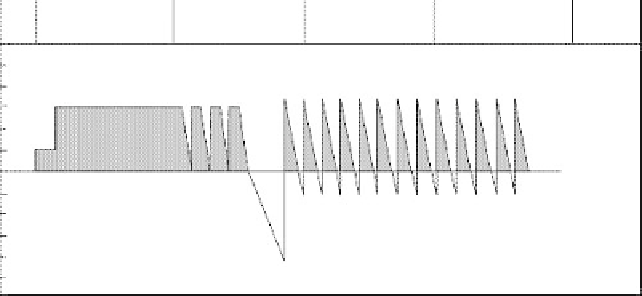Agriculture Reference
In-Depth Information
•
more clayey, acid, iron-rich soils in sediments derived from highly weathered
soils and which give iron toxicity without interflow.
Where Fe toxicity is associated with interflow the concentrations of dissolved
Fe in the upwelling water have been found to be too small to account for the
large concentrations of Fe
2
+
in the root zone, and most of the Fe
2
+
is apparently
formed
in situ
. Therefore the interflow aggravates toxicity by some mechanism
other than bringing in Fe
2
+
, possibly involving depletion of other nutrients and
upsetting the plant's ability to exclude Fe (Section 6.5).
It is often a symptom of imbalanced nutrition rather than high Fe
2
+
in the soil
solution per se. Thus the soil solution Fe
2
+
concentrations at which it is reported
vary from 10 to 1000mg L
−
1
, and it is more often associated with low levels of
P, K, Ca and Mg and impaired ability of roots to exclude Fe
2
+
.
7.2.3 ORGANIC ACIDS
Decomposition of organic matter in submerged soils produces phytotoxic com-
pounds such as aliphatic and phenolic acids (Takajima, 1964; Tsutsuki and Pon-
namperuma, 1987). Many of the potentially phytotoxic compounds are produced
only transiently, so it is difficult to assess the damage they cause. The most cer-
tain effects are seen in rice soils to which large quantities of organic manures
are added, especially under temperate conditions. As a result, in ricefields in
Japan and China, where organic manures are widely used, to avoid accumula-
tion of phytotoxins in the root zone, greater percolation rates are maintained—5
to 10mmday
−
1
compared with 1 to 5mm day
−
1
elsewhere—and water is often
completely drained from the fields midseason (Figure 7.4). This is less critical in
tropical countries because higher temperatures allow the toxins to be decomposed
more rapidly, and the use of organic manures is less.
May
June
July
August
Sept.
5 cm (Submergence)
(Intermittent
drainage)
(Intermittent irrigation)
4
3
2
1
Soil
surface
90%
80
70
60
50
(Midsummer drainage)
Figure 7.4
Water management in ricefields in Japan and parts of China (modified
from Yukawa, 1989). Reproduced by permission of the Japanese Society of Irrigation,
Drainage and Reclamation Engineering

